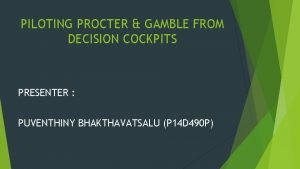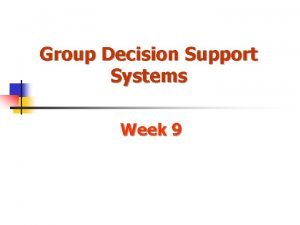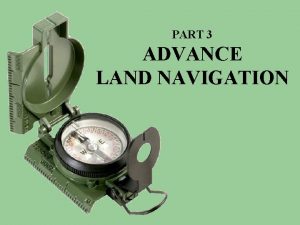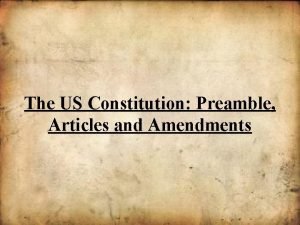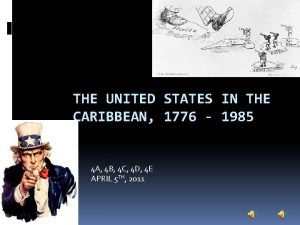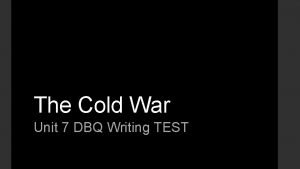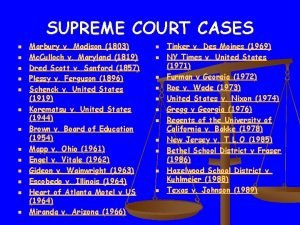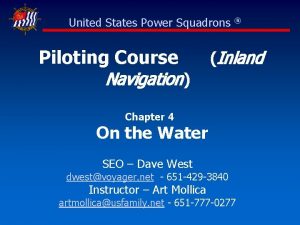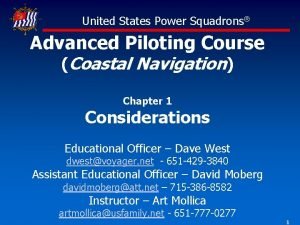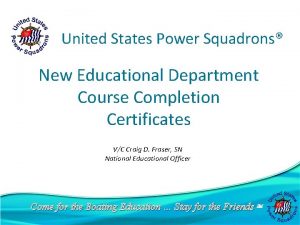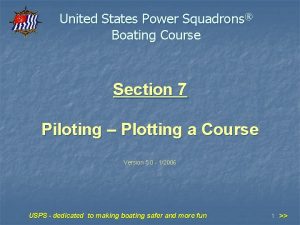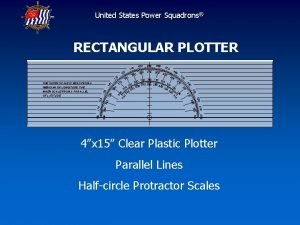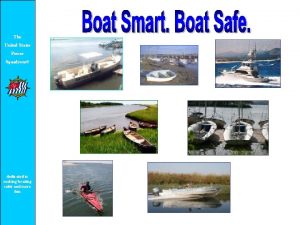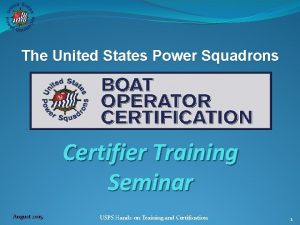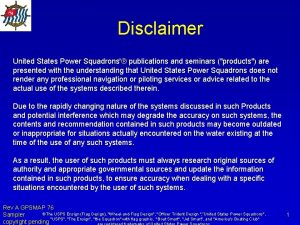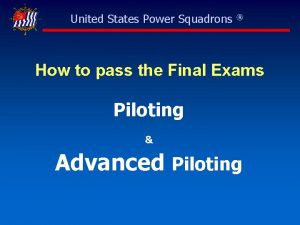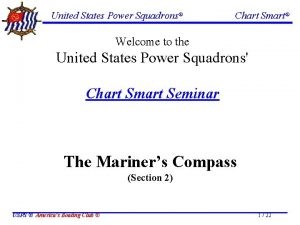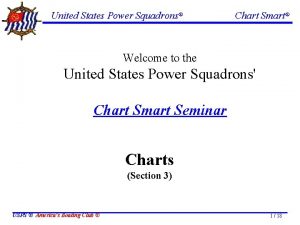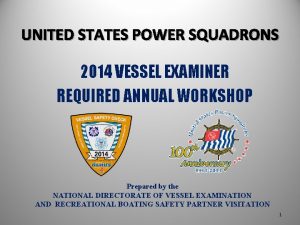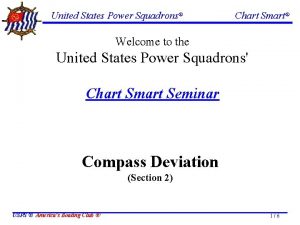United States Power Squadrons Piloting Course Navigation Inland



















- Slides: 19

United States Power Squadrons Piloting Course Navigation) ® (Inland Chapter 8 Review SEO – Dave West dwest@voyager. net - 651 -429 -3840 Instructor – Art Mollica artmollica@usfamily. net - 651 -777 -0277

Any questions on homework from Chapter 7? 1. You discover your GPS data is not correct. You are in open water away from immediate danger. You find the batteries in your backup unit are dead. Next you try to: (d) take bearings on visible marks and plot on your chart. SG-Ch 7, ¶ 4 2. Upon GPS failure, in addition to compass bearings to determine location, there are several alternatives to be considered. Which of the following are NOT recommended? (d) radio authorities to confirm location. WN-Ch 12, pg 146 3. Depth can often be used to confirm your location by: (a) comparing the depth with that charted for your assumed location. WN-Ch 12, pg 147 4. Dead Reckoning allows you to determine your likely location by: (b) calculations using 60 D=ST with direction from your last known fix. SG-Ch 7, ¶ 6 5. Your GPS has failed. After your likely position is determined, your next action should be (d) review any hazards along the route to your next waypoint. WN-Ch 12, pg 147 2

Any questions on homework from Chapter 7? Answer the next two questions using the figures below. (1) (2) (3) (4) 6. When labeling a chart for a Fix the proper symbol to use is: (d) 4 7. When labeling a chart for a Dead Reckoning position the proper symbol to use is: (c) 3 SG-Ch 3, ¶ 8 8. A reasonable estimate of heading accuracy (including compass accuracy, ability to read the compass, sea action on the boat and helmsmanship) is: (b) +/- 5º SG-Ch 4, ¶ 30 9. When using Dead Reckoning, it is a good idea to occasionally plot your position using bearings, because of: (d) cumulative error and external forces. WN-Ch 2, pg 15 SG-Ch 3, fig 3 -1 3

Cruise Part IV #13 13, You arrive at G “ 7” Fl G 4 s at 1634 and increase your speed to 30 kn. You arrive at G C “ 1” at 1642 and slow down to 5. 0 kn. You arrive at G C “ 3” at 1653 and drop off your son at 1715, he takes the GPS with him. You return to G C “ 1”. You plan to spend the evening at Perkins Cove with friends at a cookout. The most logical plan would be to go to R N “ 2” near the breakwater at Perkins Cove. However, the sunset will be at 1821 and the entrance to the cove could be dangerous in darkness. Looking over your chart you recognize the 40’ abandoned lighthouse which you know is illuminated to the west of Perkins Cove. Using the tower and the Fl R 6 s 24 ft 5 M “ 4” beacon as a range would lead you right to the entrance of the cove. To avoid the breakwater you lay a course of 081ºM for G “ 3” Q G and plot the range. Your speed will be 20 kn. BBG 03 C S 24 30 1 M. 0 BBG 07 1634 Visual 1. 7 D 1 PCR 02 D 3. 9 BFCRW C 023 M S 20. 0 12 a T = 184 V +15 W M = 199 BBG 05 a. What is the bearing of the range? 199ºM BBG 09 1642 C M = 081 W -15 W T = 066 1642 Visual M 81 C 0 0. 0 S 2 PCFLR 6 Lts in line 199 M BFCG 01 C 229 M S 5. 0 D 0. 9 BFCG 03 1300 Visual 1653 Visual 4

Cruise Part IV #14 1816 Brg M = 312 227 V -15 W T = 297 212 070 M b. What is the position of. Cthe intersection of the course and range? 12 a T = 60 D/S T = 60 x 5. 7/20 BBG 05 T = 17 ETA = 1833 XT E a. What is the ETA of the intersection of the course and range? 1833 0. 4 L 14, You leave G C “ 1” at 1802 and proceed as planned. At 1816 you decide to monitor your progress to G “ 3” Q G. With your handbearing compass you take a bearing on the CHIMNEY to the west of Haven Bluff. The bearing is 227ºM. At the same time you take a bearing on G “ 7” Fl G 4 s to your northwest. The bearing is 312ºM. The FIX indicates you’re right on course and coincides with your DR plot. S 25. 0 L 41º 38. 7’N Lo 71º 41. 7’W 13 16 BBG 09 C 023 M S 20. 0 M 81 C 0 0. 0 S 2 1642 Visual 1802 Visual BFCG 01 C 229 M C 049 M 1802 S 5. 0 D 0. 9 Visual BFCG 03 1300 Visual 1653 Visual 18 1 31 6 2 M 1816 6 1 18 1. 7 D 1 PCR 02 18 22 16 7 M 3. 9 C S 24 30 1 M. 0 BBG 07 1634 Visual D BFCRW 1816 DR 1816 – 1802 = 14 D = TS / 60 D = 14 x 20 / 60 D BBG 03 = 280 / 60 D = 4. 67 = 4. 7 nm PCFLR 6 Lts in line 199 M 5

Cruise Part IV #15 15, You pick up the range you developed at 1831 and change your course to 199ºM and follow the range to the entrance of Perkins Cove. You change speed to 10 kn. At 1845 you are between R N “ 2” and G C “ 1” and you change course to 168ºM and slow down to 5. 0 kn and continue to G C “ 7”. You arrive close aboard G C “ 7” at 1903. Again you change course to 140ºM and arrive close aboard the dock at 1914. What a great day of fishing and navigation. C 199 M S 10. 0 31 8 1 a. Why can’t you head directly for the dock from G C “ 7”? Rocks off point in back of dock b. What publication would you look at to determine the time of sunset when you were planning the cruise? Daily newspaper or www. sunrisesunset. com c. If you had the GPS, what could you do differently? Identify R N “ 2” off Perkins Cove as a waypoint 1845 C M = 168 V -15 W T = 153 1903 C M = 140 V -15 W T = 125 1914 Distance 1914 – 1903 = 11 D = TS / 60 D = 11 x 5 / 60 D = 55 / 60 D = 0. 91 = 0. 9 nm 1845 C 168 M S 5. 0 PCR 02 PCFLR 6 Lts in line 199 M 1903 Visual C 140 M S 5. 0 1914 Visual 6

Piloting Review What areas/topics do you want reviewed? 7

Common reasons for low scores § Not showing work § Not showing TVM calculations § Lack of knowledge of how to plot § Not plotting DRs, especially when bearings are taken Slide 8

How to pass the Final Exam READ THROUGH THE ENTIRE EXAM BEFORE YOU BEGIN TO PLOT AND FOLLOW ALL INSTRUCTIONS! Show all Work! § USPS wants to see that you know how to get the answer, not just § § that you got it Explicit requirement in exam instructions Most common source of lost points • Correct formula, wrong answer, part credit § In general, show – Formula with numbers plugged in: – Answer 9

Showing work for Time-Speed-Distance Example 1: You depart at 0810 at a speed of 4. 0 kts, how far have you traveled at 0943? Preliminary work: 0943 – 0810 = 93 min Formula: D = S T / 60 Formula with raw numbers plugged in: D = 4. 0 x 93 / 60 Answer: D = 6. 2 Show all the yellow information above in your exam booklet Slide 10

Showing work for Time-Speed-Distance Example 2: You depart at 0820 and travel 3. 9 miles at 4. 0 kts, what is your ETA? Formula: T = 60 D / S Formula with raw numbers plugged in: T = 60 x 3. 9 / 4. 0 Answer: T = 58. 9 = 59 Post work: ETA = 0820 + 59 = 0919 Show all the yellow information above in your exam booklet Slide 11

Showing work for TVM Example 3: With your hand bearing compass, you measure a bearing to the lighthouse of 255 degrees, plot and label it Formula TB V MB Answer 240 T 15 W 255 M Show all the yellow information above in your exam booklet Slide 12

Measure directions in True, use TVM § You will lose credit if TVM calculations not shown – measure in true (explicit requirement in exam instructions) and do (and show!) TVM calculations § If you wish, you can measure against magnetic rose to check Slide 13

Plotting and Labeling § Be sure to follow the plotting and labeling standards • in your text • on the USPS web site § If uncertain, review the cruise plot § Don’t forget to plot DRs when doing DR navigation!! • At every “navigational event” § Change of course § Change of speed § Taking a bearing § Getting a FIX • Not needed if within a qualified path using GPS Slide 14

Plotting and Labeling (con’t) § Remember • Fix times are horizontal al n o g a dia • DR times are on • If fix is not by bearings, you must show source § For example, 1018 GPS § When measuring longitude, don’t forget that it increases from right to left in the western hemisphere (ie, Bowditch Bay) § Don’t show ETAs on plot • Not part of the Plotting and Labeling Standard • Just put required ETAs (and supporting calculations!) in answer book Slide 15

Miscellaneous § THINK – does your answer make sense? ? § Try to use alternate methods to check your work. For example, use the magnetic rose to check your TVM calculations. § Use the Coastal Explorer Viewer to check your course. § Be careful, be neat. If an exam grader can’t figure out your work (especially your plot) he/she can’t give it an accurate grade! Slide 16

Sample Questions 1. At 0810 you start on a course from RG “D” buoy to the N “ 2” entrance buoy to Perkins Cove at a speed of 5. 0 kn. What is your course? T - 152 a. 146º M If you don’t come within 1º of V - +15 W b. 157º M course refigure your answer. M - 167 c. 167º M d. 174º M 2. What is the latitude of your 0910 DR position? T = 0910 – 0810 = 60 min a. 41º 35. 9’N D = (S/T) / 60 come within b. 41º 36. 4’N If you don’t D = (5. 0 remeasure x 60) / 60 your c. 41º 38. 6’N position D = 5. 0 d. 41º 39. 9’N 0. 1’ of answer. Your chart work must support your answer and you must show your calculations Slide 17

Give yourself enough time Final exam takes most students eight to twelve hours to complete t Pilo ing Don’t start the night before it’s due! 18

Good Luck! “Luck can be defined as the intersection of preparation and opportunity” You are prepared… You now have opportunity Exams must be returned to Dave West by Friday, 23 March 19
 Piloting procter & gamble from decision cockpits
Piloting procter & gamble from decision cockpits Piloting procter & gamble from decision cockpits
Piloting procter & gamble from decision cockpits The united states emerges as a world power
The united states emerges as a world power Advanced land navigation
Advanced land navigation Power triangle diagram
Power triangle diagram Was the united states on the axis powers or allied powers?
Was the united states on the axis powers or allied powers? Unit 2: the united states and canada worksheet answers
Unit 2: the united states and canada worksheet answers Sectionalism map of the united states
Sectionalism map of the united states Usa pro soccer
Usa pro soccer Marshall case
Marshall case United states student association
United states student association The united states ought to provide a universal basic income
The united states ought to provide a universal basic income What is preamble
What is preamble The united states in the caribbean 1776-1985
The united states in the caribbean 1776-1985 The southeast region of the united states of america
The southeast region of the united states of america Expansion of the united states of america 1607 to 1853 map
Expansion of the united states of america 1607 to 1853 map Why did truman believe greece needed aid
Why did truman believe greece needed aid Previous owner of gadsden purchase
Previous owner of gadsden purchase Awake united states song
Awake united states song Heart of atlanta motel v. united states
Heart of atlanta motel v. united states
